Most people by the time they reach their 30s and 40s will have some form of minor disc degenerative and arthritic changes in their spine but will not be symptomatic. Degeneration is just part of the normal aging process, which can be accelerated from trauma.
The most common cause of lower back pain is muscular due to strains, sprains, and overuse injuries. These injuries result from lack of flexibility, weakness, and repetitive movement. In particular, the following can place you at risk. These risks factors are very common in moms.
Tight Hamstring, Hip Flexors, Erector Spinae
Weak Abdominals, Glutes, Hamstrings
Poor Posture with prolonged sitting and standing
Poor body mechanics with bending and lifting
When there is an injury, the body's natural response to pain and inflamation is to shut down. This is not good news for the body because as a result muscles become weaker. You experience more pain because you are doing less, leading to more weakness, and it becomes a vicious cycle.
To break this cycle you need to strengthen and stabilize. One of the most important stabilizers is the Multifidus muscle. It is a muscle you probably have never heard of unless you've been to physical therapy and put on a spinal stabilization protocol.
The Multifidus is a very important part of the core. It co-contracts with the Transverse Abdominis (TA), the deepest layer of the abdominals. They share the same fascia or connective tissue, so when one contracts it activates the other.
(Sebastian Kaulitzki/Shutterstock.com)
(Sebastian Kaulitzki/Shutterstock.com)
To strengthen the Multifidus you must understand the TA; its fibers run horizontally and wrap around the waist like a corset supporting your internal organs. To activate the TA, lie on your back with your knees bent feet flat. Find the bony parts on the front of your pelvis and place your hands just to the inside. Let your stomach relax and you will feel a softness underneath, your hands just sink in.
(Photo Credit: Le Claire Photography)
To perform a contraction of the TA, inhale breathing into the rib cage and belly. With the exhale, draw those front bones of the pelvis together and imagine the muscle corseting around your waist. Another good visual is zipping up a pair of jeans. Feel for a firmness developing under your hands. If you vocalize "haaa" or "shhhh" it can be helpful. It is very important that you don't feel your muscles pushing outward. If you do, you are not recruiting the TA and most likely engaging the Rectus Abdominis, the most superficial layer which doesn’t connect to the deep stabilizers.
Once you have practiced the TA contraction, change your hand placement to feel for the Multifidus contraction. Slide your hands around the pelvis and find the bony prominences in the middle of your back. Let your thumbs move just to either side along the columns of muscles that run up and down the back.
Inhale, breathing into the rib cage and belly. Exhale, draw your belly inward and perform the same TA contraction. This time feel for a subtle bulging outward into your thumbs. In this case a bulging outward is the correct sensation. If you move your thumbs upwards to the side of each bony segment, you will be able to feel the Multifidus working at each level of the lumbar spine. The TA contraction should be performed in different positions to restore good function and then added into an exercise program.
A great stabilization exercise to strengthen the Multifidus is the Opposite Arm/Leg Lift. Start on all fours with your knees aligned under your hips and hands under your shoulders. Find neutral spine, the mid-point between rounding and arching. Draw your lower belly inward and without moving the hips and pelvis extend one leg straight behind and the opposite arm forward. Hold 3 seconds, then change sides. Alternate sides 5 times
What is the best way to prevent lower back pain?
- Add stabilization exercises into your strengthening program
- Stretch (Hamstrings, Hip Flexors, Lower Back Muscles) and have a more comprehensive program if you are generally stiff
- Practice good posture
- Be mindful of your body mechanics
Though injuries are sometimes unavoidable, taking good care of your body will keep your back as healthy as possible.
Leave a comment and let me know what exercises you are doing to protect your back. For more information on back strengthening visit our Exercise Section.





